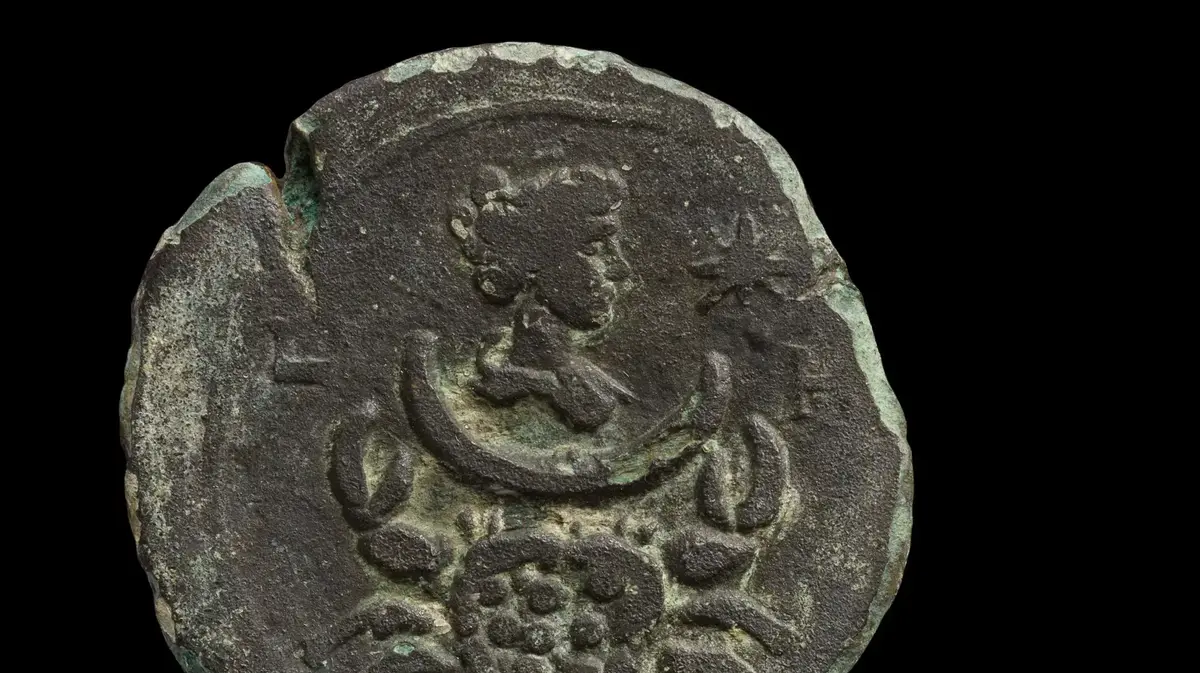A rare coin, depicting the sign of Cancer and the moon goddess, was discovered in Carmel Beach
A rare and magnificent bronze coin of about 1850 years old, depicting the sign of Cancer and the portrait of the moon goddess and is part of a series of zodiac coins, was discovered at the bottom of the sea in the Haifa area.
The Antiquities Authority says that "it is rare in the state's treasures"
Voila system!
tourism
25/07/2022
Monday, July 25, 2022, 08:48
Share on Facebook
Share on WhatsApp
Share on Twitter
Share by email
Share in general
Comments
Comments
A coin of the portrait of the Roman emperor Antoninus Pius found in Carmel (photo: Nir Distelfeld, Israel Antiquities Authority)
A rare and spectacular bronze coin, about 1850 years old and in an exceptional state of preservation, was recently discovered at the bottom of the sea during an underwater archaeological survey conducted by the Antiquities Authority at the Carmel Beach in Haifa.
The coin, which dates back to the Roman period, was minted in the name of the emperor Antoninus Pius (138-161 AD), in Alexandria, Egypt. On the back of the coin is depicted the sign of Cancer, and above it - a portrait of the moon goddess Luna. On the coin is the date "Year 8": the eighth year of the reign of Antoninus Pius, 144/5 CE.
The coin is part of a series of 13 coins, in which the 12 different zodiac signs are depicted, as well as another coin, in which the entire zodiac is depicted.
The coin bearing the image of Luna, the goddess of the moon.
Below it appears the sign of Cancer (photo: Israel Antiquities Authority, Dafna Gazit)
The date "Year 8" appears on the coin: the eighth year of the reign of Antoninus Pius (photo: Israel Antiquities Authority, Yaniv Berman)
"The first time such a coin has been discovered in the sea in Israel"
According to Yaakov Sharvit, director of the Maritime Archeology Unit at the Antiquities Authority, "This is the first time that such a coin has been discovered at sea in Israel, and it is rare among the state's treasures. Along the shores of the Mediterranean Sea in the State of Israel, and in its maritime space, there are many archaeological sites and finds that tell of connections that existed here in ancient times between The ports of the Mediterranean Sea and the countries along it. These findings, which sank into the abyss and disappeared from sight for hundreds and thousands of years, have been preserved in an amazing way, some of them are extremely rare, and their discovery completes parts of the historical puzzle of the country's history."
The coin was discovered during a survey that the Antiquities Authority is conducting these days, to locate, document, research and preserve ancient sites and ancient artifacts - cultural assets that are in danger due to the increasing development at sea.
According to Eli Escozido, director of the Antiquities Authority, "In the last decade, the State of Israel has been changing its perception of the sea. Now, it is already clear that the sea is not its border line, but is a significant part for it, in security, strategic, economic aspects - and also of heritage. It is a space of treasures Nature and cultural assets that must be explored and protected, in the face of the variety of interests and development potential. As part of this process, the marine survey was carried out in Haifa. The rare coin that was discovered during it is a spectacular reminder of the importance of the survey."
More in Walla!
An ancient ship anchorage about 4,000 years old was discovered in the Tel Dor National Park
To the full article
Kobi Sharvit, Director of the Maritime Unit of the Antiquities Authority, with the coin found in the survey in my days (Photo: Antiquities Authority, Yaniv Berman)
Portrait of the Roman Emperor Antoninus Pius (Photo: Israel Antiquities Authority, Dafna Gazit)
A Roman coin bearing the image of the Roman emperor Antoninus Pius (Photo: Israel Antiquities Authority, Dafna Gazit)
It is interesting to know that Emperor Antoninus Pius, who minted the coin, was a Roman emperor who operated between 138-161 CE. Unlike his predecessors, he was not a military man, and never participated in combat. His reign was the quietest of the entire Roman Empire, and it was the culmination of the Roman peace (Paxa-Romana) throughout the empire.
Antoninus' approach to the management of the Roman Empire was different, in that he preferred to manage all foreign crises through the provincial commissioners, and in fact did not leave Rome at all. He encouraged and initiated the construction of temples, theaters, buildings luxurious burials (mausoleum) and promoted science and philosophy. During his time, the emperor's relations with the Jews were greatly eased, Hadrian's decrees were repealed, and circumcision was approved for the Jews. These easements led to friendly ties between the emperor and Rabbi Yehuda the President.
tourism
news
Tags
Archaeology
coins












/cloudfront-eu-central-1.images.arcpublishing.com/prisa/S7ERVSCT4FUVX6R7TUVBDNTH5Y.jpg)


